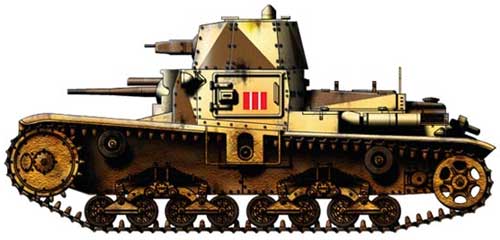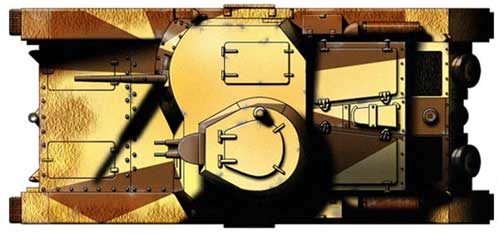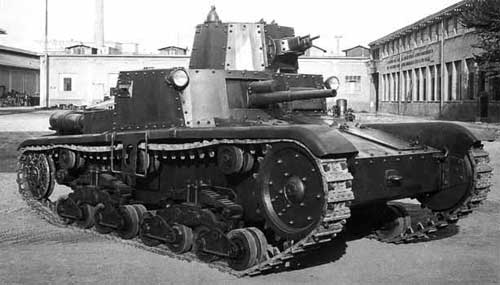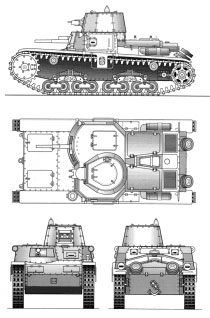
Italian medium tank M-11/39
Italian medium tank M-11/39Fiat M11 / 39.
The driver was located on the left, behind him was a turret with a twin installation of two 8-mm machine guns, and a 37-mm long-barreled gun was mounted on the right side of the turret space. In the undercarriage, 8 rubberized road wheels of small diameter were used per side. The road wheels were interlocked in pairs in 4 carts. In addition, there were 3 support rollers on each side. The tanks used small-link metal tracks. Since the armament and armor protection of the M-11/39 tank were clearly insufficient, these tanks were produced for a relatively short time and were replaced in the production of the M-13/40 and M-14/41 By 1933, it became obvious that tankettes were not a sufficient replacement for the obsolete Fiat 3000, in connection with which it was decided to develop a new tank. After experimenting with the heavy (12t) version of the CV33 based machine, the choice was made in favor of the light version (8t). By 1935, the prototype was ready. The 37 mm Vickers-Terni L40 gun was located in the superstructure of the hull and had only a limited traverse (30 ° horizontally and 24 ° vertically). The loader-gunner was located on the right side of the fighting compartment, the driver was on the left and slightly behind, and the commander controlled two 8-mm Breda machine guns mounted in the turret. The engine (still standard) through the transmission drove the front drive wheels.
Field tests showed that the tank engine and transmission needed to be refined. A new, round tower was also developed to reduce the cost and speed up production. Finally, by 1937, a new tank designated the Carro di rottura (breakthrough tank) went into production. The first (and only) order was 100 units. A shortage of raw materials delayed production until 1939. The tank went into production under the designation M.11 / 39, as a medium tank weighing 11 tons, and entered service in 1939. The final (serial) version was slightly higher and heavier (over 10 tons), and did not have a radio, which is difficult to explain, since the prototype of the tank had an onboard radio station.
In May 1940, M.11/39 tanks (24 units) were sent to the AOI (“Africa Orientale Italiana” / Italian East Africa). They were grouped into special M. tank companies (“Compagnia speciale carri M.”), to reinforce the Italian positions in the colony. After the first combat clashes with the British, the Italian field command was in dire need of new combat vehicles, since the CV33 tankettes were completely useless in the fight against British tanks. In July of the same year, the 4th Panzer Regiment, consisting of 70 M.11 / 39, landed in Benghazi.
The first combat use of the M.11 / 39 tanks against the British was quite successful: they supported the Italian infantry in the first offensive on Sidi Barrani. But, just like the CV33 tankettes, the new tanks showed mechanical problems: in September, when the armored group reorganized the 1st battalion of the 4th tank regiment, it turned out that only 31 of the 9 vehicles remained on the move in the regiment. The first collision of M .11 / 39 tanks with British tanks showed that they are far behind the British in almost all respects: in firepower, armor, not to mention the weakness of the suspension and transmission.
As a result of the next major defeat, which occurred at the beginning of 1941, almost all the M.11 / 39 tanks were destroyed or captured by the enemy. Since the obvious inability of these machines to provide at least some cover for the infantry became clear, the crews without hesitation threw the immobilized vehicles. The Australians armed a whole regiment with captured Italian М.11 / 39, but they were soon withdrawn from service due to the complete inability of these tanks to fulfill the assigned combat missions. The remaining (only 6 vehicles) were used in Italy as training vehicles, and were finally withdrawn from service after the conclusion of the armistice in September 1943. M.11 / 39 was designed as an infantry support tank. In total, from 1937 (when the first prototype was released) to 1940 (when it was replaced by the more modern M.11 / 40), 92 of these machines were produced. They were used as medium tanks for missions that far exceeded their capabilities (inadequate armor, weak armament, small diameter road wheels and narrow track links). During the early fighting in Libya, they had no chance against the British Matilda and Valentine. Performance characteristics
Sources:
|

 The M-11/39 tank was developed by Ansaldo and put into mass production in 1939. He was the first representative of the “M” class - medium vehicles according to the Italian classification, although in terms of combat weight and armament this tank and the tanks M-13/40 and M-14/41 that followed it should be considered light. This car, like many of the "M" class, used a diesel engine, which was located in the rear. The middle part was occupied by the control compartment and the fighting compartment.
The M-11/39 tank was developed by Ansaldo and put into mass production in 1939. He was the first representative of the “M” class - medium vehicles according to the Italian classification, although in terms of combat weight and armament this tank and the tanks M-13/40 and M-14/41 that followed it should be considered light. This car, like many of the "M" class, used a diesel engine, which was located in the rear. The middle part was occupied by the control compartment and the fighting compartment.




 In December 1940, when the British launched their offensive, the 2nd Battalion (2 companies M.11 / 39) was suddenly attacked near Nibeiwa, and in a short time lost 22 of its tanks. The 1st Battalion, which by that time was part of the new Special Armored Brigade, and which had 1 company M.11 / 39 and 2 companies CV33, was able to take only a small part in the battles, since most of its tanks were being repaired in Tobruk (Tobruk).
In December 1940, when the British launched their offensive, the 2nd Battalion (2 companies M.11 / 39) was suddenly attacked near Nibeiwa, and in a short time lost 22 of its tanks. The 1st Battalion, which by that time was part of the new Special Armored Brigade, and which had 1 company M.11 / 39 and 2 companies CV33, was able to take only a small part in the battles, since most of its tanks were being repaired in Tobruk (Tobruk).